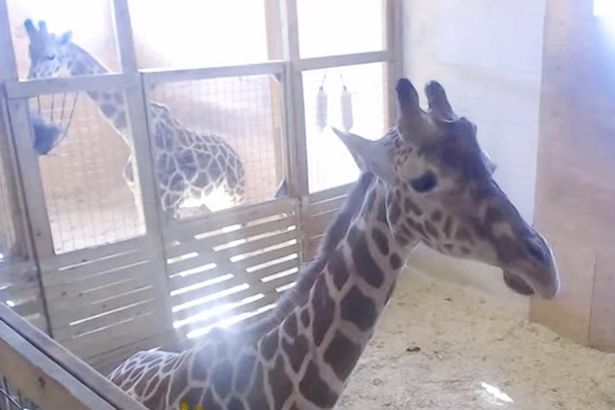April the giraffe is FINALLY giving birth after months of the world watching and waiting for her calf to arrive
This is not a drill – the calf’s hooves have been seen emerging from the birth canal

Click On the Headlines Or Image for the complete News, Videos and more photos.
The giraffe (Giraffa) is a genus of African even-toed ungulate mammals, the tallest living terrestrial animals and the largest ruminants. The genus consists of eleven or more species including Giraffa camelopardalis, the type species. Seven of these species are extinct, prehistoric species known from fossils, though numerous subspecies have been described and its taxonomy is not definitively set. Indeed, research into the mitochondrial and nuclear DNA of Giraffa has suggested to recognize four to six distinct extant species. The four-species taxonomic classification, proposed in 2016 but criticized since then, has the genus Giraffa composed of the species Giraffa giraffa (southern giraffe), Giraffa tippelskirchi (Masai giraffe), Giraffa reticulata (reticulated giraffe) and Giraffa camelopardalis (northern giraffe).
The giraffe’s chief distinguishing characteristics are its extremely long neck and legs, its horn-like ossicones, and its distinctive coat patterns. It is classified under the family Giraffidae, along with its closest extant relative, the okapi. Each of the four species is distinguished by its coat patterns and genetics. Its scattered range extends from Chad in the north to South Africa in the south, and from Niger in the west to Somalia in the east. Giraffes usually inhabit savannahs and woodlands. The giraffe’s source is leaves, fruits and flowers of woody plants, primarily acacia species, which they browse at heights most other herbivores cannot reach. Giraffes may be preyed on by lions, leopards, spotted hyenas and African wild dogs. Giraffes live in herds of related females and their offspring, or bachelor herds of unrelated adult males, but are gregarious and may gather in large aggregations. Males establish social hierarchies through “necking”, which are combat bouts where the neck is used as a weapon. Dominant males gain mating access to females, which bear the sole responsibility for raising the young.
Source : wikipedia

